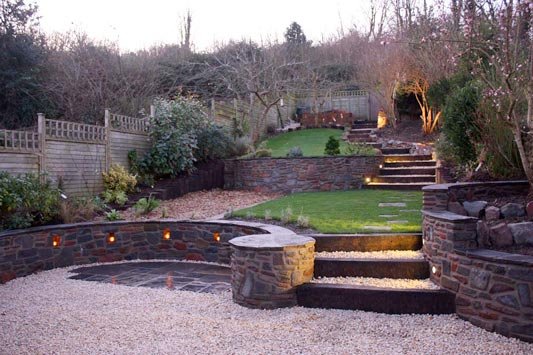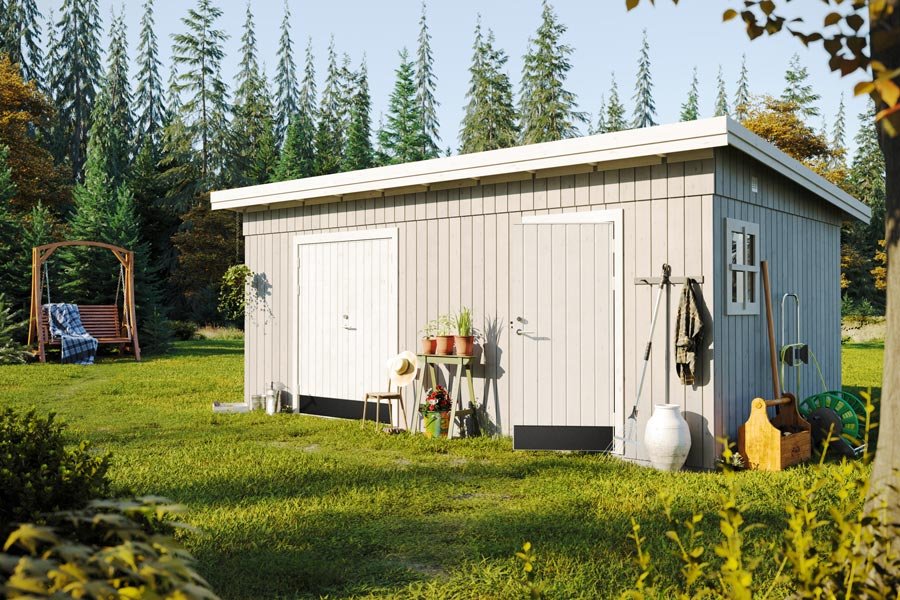Sloping garden design inspiration

5 ideas for hillside garden landscaping
Designing your dream garden can be daunting at the best of times; if you have a sloping patch, things can seem especially tricky. But there are a host of ways to work around the tilt.
Here are 5 tips on how to turn your garden’s awkward angle into an asset. They’ll help you conquer some of the commonest problems with poor sloping garden design – such as difficulties with mowing the lawn, half of the garden being un-used or un-usable, or soil erosion.
They’ll also give you alternatives to expensive and heavy-duty landscaping and retaining walls.
Include terracing in your sloping garden design

The traditional way to overcome your garden’s gradient is terracing – basically turning a slope into a series of flat surfaces with different levels and steps.
This makes gardening simpler, and allows you to use different styles on different levels.
Terracing materials can also be an intrinsic part of the sloping garden design. You can use a whole range of materials to terrace your garden, including different types of stone, wood, metal sheeting, brick and even old tyres. These allow a choice of eye-catching surfaces if your garden slopes upwards, and you’ll find plenty of inspiration on websites like Pinterest and Houzz.
However, if your garden slopes downwards, there’s less opportunity to create interest through the actual terracing materials.
The downside of terracing is that it can be intensive in terms of effort and cost, particularly if your slope is steep. Unless you fancy a challenge, have a tiny plot or really know your stuff, it is wise to consult a professional landscaper or builder. But a good garden designer will be able to suggest cheaper alternatives to building expensive retaining walls and foundations, as this blog on using old railway sleepers in a design shows.
Another cost-effective option for creating terracing is gabions. These are wire cages filled with stone, commonly used in civil engineering projects, such as road building, but used in garden landscaping too. They can be cheaper than building retaining walls, and also look more contemporary, as an interesting blog by Alda Landscapes shows.
Use planting to improve your hillside garden

A great way to manipulate the feel of your sloping plot is to play around with what plants you place where in the garden. For example, on land sloping downwards from the house, planting tall foliage at the bottom can reduce your perception of the tilt.
However, planting tall plants or trees at the high end of an upward-sloping garden could make it feel enclosed and overpowering. And looking upwards at a border can make tall plants look absurdly tall and dominating. So, as this advice in the Guardian shows, if you plant a border on a slope, you may have to relearn the rules about what should be planted where.
Plants can also be used to stabilise a slope and prevent soil erosion. There’s a good selection of low-maintenance, groundcover plants suitable for the steepest of slopes on this site, and they can add colour and texture to your sloping garden design..
Decking in a sloping garden design?

Installing decking and creating a wooden patio-type feature at the bottom of your garden can look really good as it will give the garden a focal point and catch the eye (in turn drawing attention away from the slant). It can also transform a neglected, unloved part of the garden into a social area, where you can entertain.
It can enable you to install a showpiece structure (which could be otherwise impossible given the incline) such as a water feature or pergola which is sure to be seen. And installing a garden shed or summer house on decking means you don’t have to worry about uneven, sloping foundations, or water pooling.
Do, if you have neighbours close by, do careful about installing a summerhouse or shed at the top of a garden slope – the effect could be a bit like a watchtower, with the neighbours feeling they’re under unwelcome scrutiny all the time (the photo above is of the lovely GardenLife Claudia clock-house style summer house positioned right at the top of a steep slope in a customer’s back garden – not our call).
For ideas on how to use decking in sloping gardens – plus words of warning about some of the pitfalls – have a look at the top deck website.
This is an aspect of sloping garden design where an angle is actually really useful as it gives you scope to install kinetic water features. Instead of a sedentary pond, you could have multiple pools connected by streams or small waterfalls (since the slope and gravity will do most of the work for you) – your very own miniature version of the famous waterworks at Chatsworth.
Or you could create a mini river-rapids style rock cascade – the Falls of Clyde in your own backyard. Having a dynamic feature like this could really command attention and bring the garden alive.
If you don’t have Chatsworth’s Capability Brown to design your water feature for you, there’s a good selection on the Primrose website.
Paths in a hillside garden

If terracing or decking are too high maintenance and/or costly for your sloping garden design, creating a inclined, winding walkway can reduce a slope’s prominence (whether it slopes upwards or downwards) and create a journey-like effect.
An S-shaped path with large sections of foliage will break up the space and take attention away from the slope whilst the hillside will give the path dimension.
However, if your garden’s list is particularly drastic, getting up or down path could prove impractical in winter weather or for the elderly, even if the path snakes across the hillside.
There is good basic and practical advice on building a garden path on the Wickes website.
Whatever you choose to incorporate into your new sloping garden design, the inspirational ideas, examples and links above should help get you started.


















